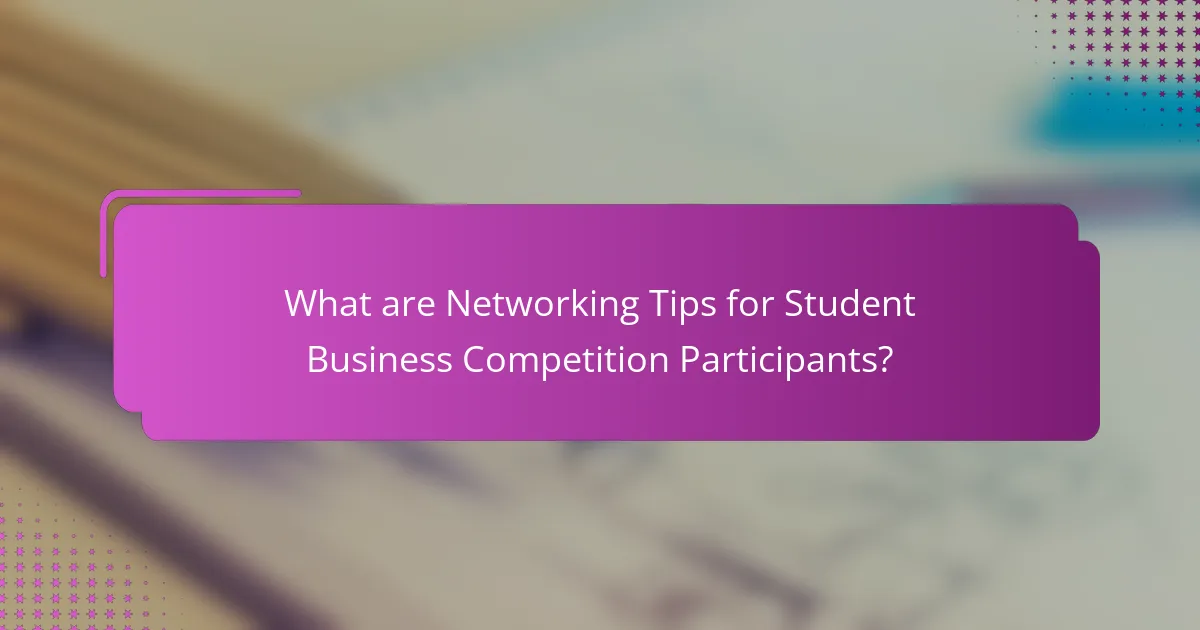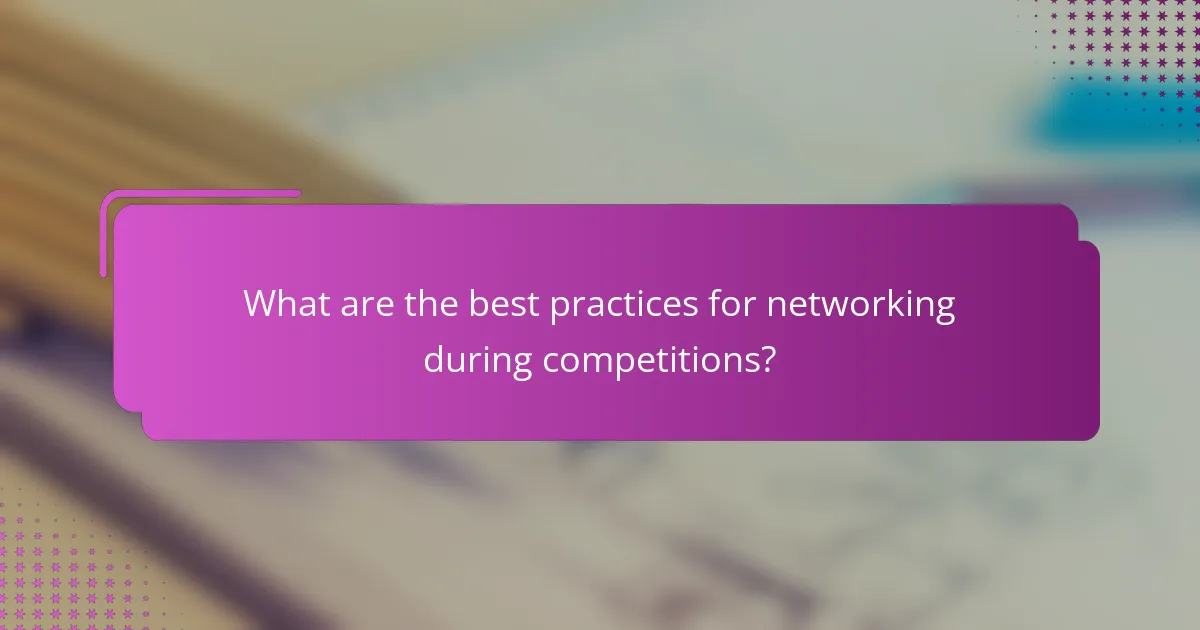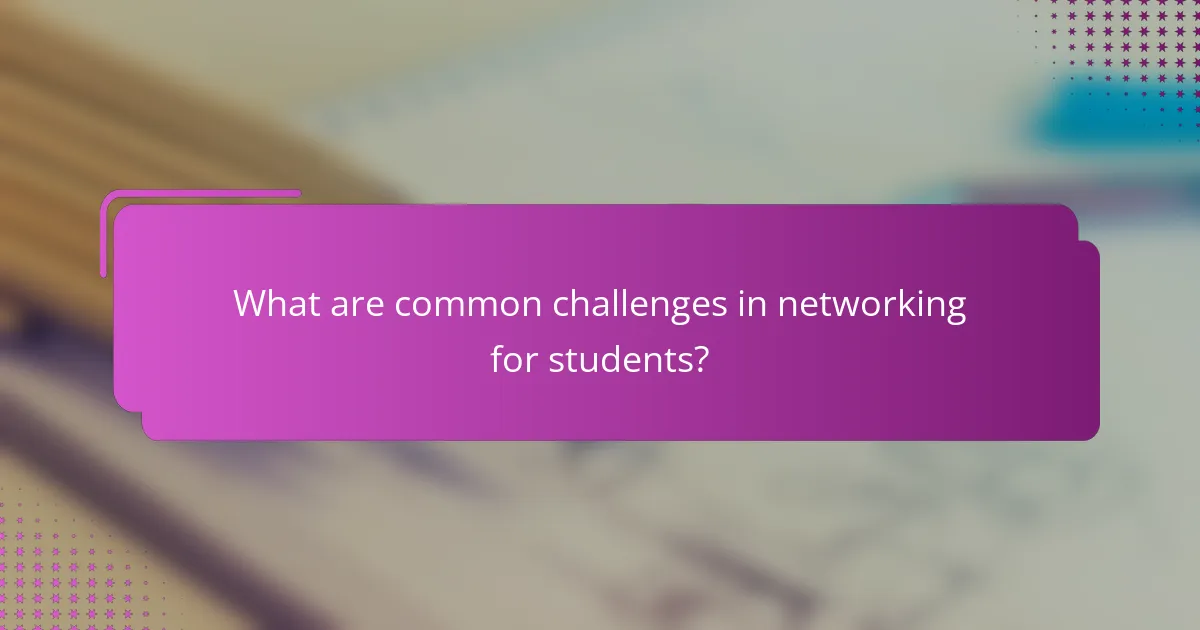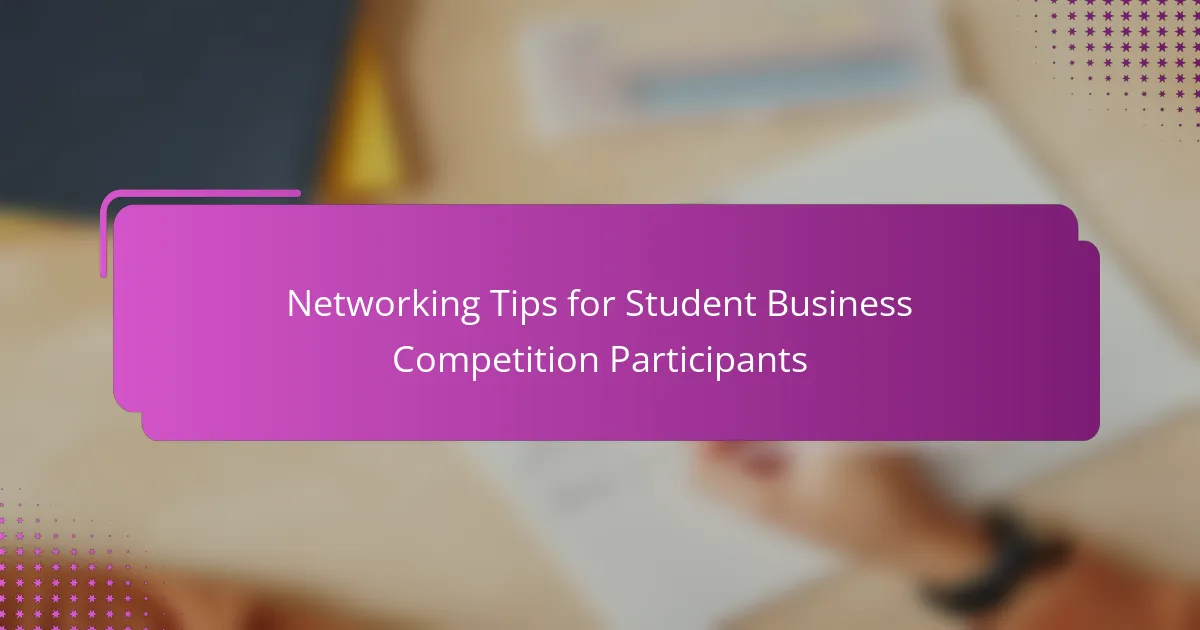Networking strategies for student business competition participants are essential for building professional connections and enhancing opportunities. Key practices include thorough preparation, active engagement during events, and effective follow-up after competitions. Participants should research attendees and speakers to facilitate meaningful conversations and practice their elevator pitch to communicate their skills and goals clearly. Engaging with others through open-ended questions and attending workshops can foster valuable interactions. Addressing common challenges such as lack of experience and confidence is vital for maximizing networking potential and establishing lasting relationships.

What are Networking Tips for Student Business Competition Participants?
Networking tips for student business competition participants include being prepared, actively engaging, and following up. Participants should research attendees and speakers before the event. This knowledge allows for meaningful conversations. Practicing an elevator pitch is essential. A concise introduction showcases skills and goals. Participants should also ask open-ended questions. This encourages dialogue and demonstrates interest. Attending workshops and breakout sessions provides networking opportunities. Building connections with peers can lead to future collaborations. After the event, following up with contacts is crucial. A simple thank-you message can reinforce relationships. These strategies enhance networking effectiveness in competitions.
How can effective networking impact student business competition outcomes?
Effective networking can significantly enhance student business competition outcomes. Networking provides access to valuable resources and mentorship opportunities. It allows students to connect with industry professionals and potential investors. These connections can lead to partnerships that strengthen business proposals. Networking also facilitates the exchange of ideas and best practices among peers. This collaborative environment can inspire innovative solutions to competition challenges. Furthermore, students with strong networks often receive constructive feedback that improves their projects. Research shows that teams with diverse networks tend to perform better in competitions. These advantages collectively contribute to higher chances of success in student business competitions.
What are the key networking strategies for students in competitions?
Key networking strategies for students in competitions include building relationships, leveraging social media, and attending networking events. Building relationships involves engaging with peers and mentors before, during, and after competitions. This creates a support system and opens opportunities for collaboration. Leveraging social media, particularly platforms like LinkedIn, helps students connect with industry professionals and showcase their work. Attending networking events allows students to meet potential collaborators and learn from experienced individuals in their field. Research shows that 70% of jobs are found through networking, highlighting its importance in competitions. Engaging with alumni can also provide valuable insights and connections.
How does networking enhance collaboration among team members?
Networking enhances collaboration among team members by fostering open communication and trust. It allows individuals to share ideas and resources effectively. When team members engage with each other and external contacts, they build relationships that encourage collaboration. Networking creates opportunities for knowledge exchange, leading to innovative solutions. Research indicates that teams with strong networks perform better in collaborative tasks. A study by the Harvard Business Review shows that effective networking increases team productivity by 25%. This demonstrates the significant impact networking has on enhancing teamwork and collaboration.
Why is networking important for student entrepreneurs?
Networking is crucial for student entrepreneurs because it facilitates access to resources and opportunities. Building connections can lead to mentorship, funding, and partnerships. Networking also helps students gain insights from experienced professionals in their fields. According to a study by the Kauffman Foundation, 75% of entrepreneurs credit their networks for their business success. Engaging with peers and industry leaders enhances knowledge sharing and collaboration. Additionally, networking can improve visibility and credibility in the entrepreneurial ecosystem. These factors contribute significantly to the growth and sustainability of student-led ventures.
What opportunities can networking provide for student business participants?
Networking provides student business participants with valuable connections, mentorship, and potential job opportunities. These connections can lead to collaborations and partnerships in future projects. Mentorship from experienced professionals can offer guidance and insights into the industry. Additionally, networking can enhance students’ visibility among potential employers. According to a survey by the National Association of Colleges and Employers, 85% of jobs are filled through networking. This statistic underscores the importance of building relationships within the business community.
How does networking contribute to skill development for students?
Networking significantly contributes to skill development for students. It provides opportunities to connect with industry professionals. These connections can lead to mentorship and guidance in specific fields. Students can gain insights into real-world applications of their studies. Networking events often include workshops that enhance practical skills. Engaging with peers fosters collaboration and teamwork abilities. Students also develop communication skills through networking interactions. Research shows that networking can lead to internships, which further develop professional competencies.

What are the best practices for networking during competitions?
The best practices for networking during competitions include being prepared, engaging actively, and following up after the event. Participants should research attendees and speakers beforehand to identify potential connections. They should introduce themselves confidently and ask open-ended questions to foster conversation. Actively listening and showing genuine interest in others’ ideas is crucial. Participants can exchange contact information and connect on professional networks like LinkedIn. Following up with personalized messages after the competition reinforces connections and opens the door for future collaborations. These practices enhance networking effectiveness and can lead to valuable opportunities.
How can students prepare for networking at business competitions?
Students can prepare for networking at business competitions by researching participants and judges. Understanding their backgrounds helps in initiating conversations. Practicing an elevator pitch is crucial. A concise introduction highlights key strengths and objectives. Students should also prepare thoughtful questions to engage others. This demonstrates genuine interest and fosters connections. Dressing appropriately enhances professionalism and confidence. Utilizing business cards can facilitate easy information exchange. Finally, following up with contacts post-competition solidifies relationships and opens future opportunities.
What materials should students bring to facilitate networking?
Students should bring business cards to facilitate networking. Business cards provide essential contact information. They allow for easy sharing of details with potential connections. Students should also carry a notepad and pen. This helps in taking notes during conversations. A digital device, like a smartphone or tablet, can be useful. It allows for quick access to LinkedIn or other networking platforms. Additionally, students should bring a professional portfolio. This showcases their work and skills effectively. Having a clear elevator pitch prepared is also crucial. It aids in making a strong first impression.
How can students effectively introduce themselves to potential connections?
Students can effectively introduce themselves to potential connections by clearly stating their name and purpose. They should begin with a confident greeting. Following that, they should share their academic background and interests. This establishes common ground. Students can also mention specific goals related to networking. This helps to create relevance in the conversation. Additionally, they should ask open-ended questions to engage the other person. This encourages dialogue and builds rapport. According to a study by the University of California, effective networking can lead to increased opportunities and collaborations.
What techniques can enhance networking effectiveness?
Effective networking can be enhanced through several techniques. First, actively listening during conversations fosters stronger connections. This shows genuine interest in others’ perspectives. Second, maintaining eye contact builds trust and rapport. Third, following up after initial meetings reinforces relationships. Sending personalized messages can leave a positive impression. Fourth, utilizing social media platforms like LinkedIn helps in staying connected. Regularly engaging with contacts through posts or messages keeps relationships alive. Fifth, attending industry events or workshops offers opportunities to meet like-minded individuals. Research indicates that 85% of job openings are filled through networking, highlighting its importance. Lastly, practicing an elevator pitch ensures clarity in conveying personal goals and interests.
How can students leverage social media for networking?
Students can leverage social media for networking by creating professional profiles on platforms like LinkedIn. These profiles should showcase their skills, experiences, and achievements. Engaging with industry-related content can help students connect with professionals in their field. Joining relevant groups and participating in discussions increases visibility and networking opportunities. Students should also follow companies and influencers to stay informed about industry trends. Attending virtual events and webinars advertised on social media allows for direct interaction with industry experts. Research shows that 70% of jobs are found through networking, highlighting the importance of these connections.
What role does follow-up play in successful networking?
Follow-up is crucial in successful networking as it helps solidify connections made during interactions. It demonstrates professionalism and genuine interest in maintaining relationships. Effective follow-up can lead to opportunities for collaboration, mentorship, or job prospects. Statistics show that 80% of sales require five follow-ups after the initial contact. Additionally, timely follow-up increases the likelihood of being remembered, as most people forget interactions shortly after they occur. Therefore, consistent follow-up strategies are essential for leveraging networking efforts effectively.

What are common challenges in networking for students?
Common challenges in networking for students include lack of experience, confidence issues, and limited access to opportunities. Many students feel unsure about how to approach professionals. This hesitation can hinder their ability to make connections. Additionally, students often struggle with articulating their goals and interests. This can lead to ineffective conversations. Time constraints also pose a challenge, as students balance academics and networking efforts. Finally, students may lack knowledge of effective networking strategies. This can prevent them from maximizing their networking potential.
What obstacles do students face when networking in competitions?
Students face several obstacles when networking in competitions. One significant challenge is a lack of confidence. Many students feel intimidated by industry professionals. This can hinder their ability to initiate conversations. Another obstacle is limited networking skills. Students may not know how to effectively introduce themselves. Time constraints also play a role. Competitions often have tight schedules, leaving little time for networking. Additionally, students might struggle with follow-up. They may fail to maintain connections after the event. Lastly, cultural differences can create barriers. Students from diverse backgrounds may find it difficult to communicate effectively. These factors collectively impact students’ networking experiences in competitions.
How can students overcome shyness or anxiety in networking situations?
Students can overcome shyness or anxiety in networking situations by practicing effective communication skills. Engaging in role-playing exercises can simulate networking scenarios. This preparation builds confidence and reduces anxiety. Additionally, students can set specific networking goals, such as initiating conversations with three new people. Research shows that setting clear objectives enhances performance in social interactions. Students should also focus on active listening, which fosters connection and makes conversations easier. Joining clubs or groups related to their interests can provide comfortable networking environments. Gradual exposure to networking events increases familiarity and reduces anxiety over time.
What strategies can help students deal with rejection in networking?
Students can deal with rejection in networking by adopting resilience strategies. First, they should reframe rejection as a learning opportunity. This perspective allows students to analyze what went wrong and improve future interactions. Second, building a support network can provide emotional backing. Engaging with peers who share similar experiences can foster a sense of belonging. Third, practicing self-compassion helps students manage their feelings. Recognizing that rejection is a common experience can reduce its emotional impact. Fourth, setting realistic expectations is crucial. Understanding that not every connection will lead to success can mitigate disappointment. Lastly, maintaining a growth mindset encourages perseverance. This mindset focuses on long-term goals rather than immediate setbacks. These strategies can help students navigate the challenges of networking effectively.
How can students build lasting professional relationships?
Students can build lasting professional relationships by actively engaging with peers and mentors. Networking events provide opportunities to connect with industry professionals. Students should attend workshops and seminars related to their field. Following up with contacts after initial meetings reinforces connections. Utilizing social media platforms like LinkedIn can help maintain relationships. Regular communication through emails or messages shows commitment. Offering assistance or collaboration can strengthen bonds. Research indicates that networking can lead to job opportunities, with 70% of jobs found through personal connections.
What are the key elements of maintaining connections after competitions?
The key elements of maintaining connections after competitions include follow-up communication, networking events, and social media engagement. Follow-up communication is essential for reinforcing relationships. Sending personalized messages or emails to participants can keep the dialogue open. Networking events provide opportunities to reconnect and strengthen bonds. Attending industry-related gatherings helps maintain visibility. Social media engagement allows for ongoing interaction. Sharing relevant content and commenting on posts fosters connections. Regular check-ins can also help sustain relationships over time. These practices are vital for long-term networking success.
How can students provide value to their network over time?
Students can provide value to their network over time by sharing knowledge and resources. They can offer insights from their academic experiences and research projects. Engaging in discussions and providing feedback enhances relationships. Students can also connect peers with industry professionals. Organizing study groups fosters collaboration and shared learning. Regularly attending networking events keeps connections active. They can share relevant articles or industry news to keep their network informed. Volunteering for projects or initiatives creates opportunities for mutual support.
What practical networking tips can students implement immediately?
Students can implement several practical networking tips immediately. First, they should create a professional LinkedIn profile. This platform allows students to connect with industry professionals and peers. Next, attending networking events is crucial. Students can meet potential mentors and collaborators at these gatherings. Additionally, students should practice their elevator pitch. A concise introduction helps make a strong first impression.
Joining student organizations related to their field is also beneficial. These groups often provide networking opportunities and resources. Furthermore, students should utilize social media effectively. Engaging with industry-related content can increase visibility. Finally, following up with new contacts is essential. A simple thank-you email can solidify connections made during networking.
How can students create an effective elevator pitch for networking?
Students can create an effective elevator pitch for networking by following a structured approach. First, they should define their main message clearly. This message should highlight their skills, experiences, and goals. Next, students should keep the pitch concise, ideally lasting 30 to 60 seconds. They should practice delivering the pitch confidently and with enthusiasm. Using an engaging opening can capture the listener’s attention. Additionally, students should tailor their pitch to the audience, aligning their message with the listener’s interests. Finally, incorporating a call to action can encourage further conversation. Research shows that a well-prepared pitch increases networking success rates.
What are the best ways to approach networking at events?
The best ways to approach networking at events include being prepared, initiating conversations, and following up afterward. Preparation involves researching attendees and creating a clear introduction. Initiating conversations can be done by asking open-ended questions and showing genuine interest. It’s important to actively listen and engage in the discussion. Following up with connections via email or social media solidifies relationships. According to a study by the Harvard Business Review, networking increases job opportunities by 70%. This highlights the effectiveness of proactive networking strategies.
The main entity of the article is “Networking Tips for Student Business Competition Participants.” This article provides essential strategies for effective networking, emphasizing preparation, active engagement, and follow-up to enhance participants’ experiences and outcomes in business competitions. It covers the impact of networking on collaboration, skill development, and access to resources, as well as practical tips for creating elevator pitches and maintaining professional relationships. Additionally, the article addresses common challenges students face in networking scenarios and offers techniques to overcome these obstacles, ensuring a comprehensive understanding of effective networking practices.
